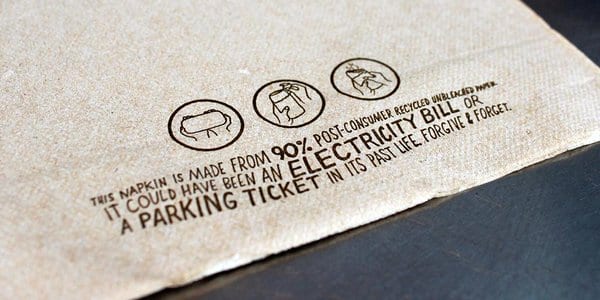
If you browse the “napkins” tag on Twitter, you will find that nearly all such tweets can be categorized in one of three ways: 1) people complaining that [insert fast food chain] doesn’t provide enough napkins 2) people pontificating that they “must be the ONLY person to hoard napkins in their glovebox/console” (FYI this is a near-universal phenomenon whose untapped marketing potential we will discuss at a later time) and 3) people thanking Chipotle for their gratuitous napkin provision.
So let’s talk about point number three… how this rather innocuous detail of Chipotle’s business practice has such a profound impact on the Twittersphere:
What the Napkin Is:
Chipotle’s napkin is simple. It is a one-ply kraft dispenser napkin, with custom printing in brown ink on both the front and back panels. The front panel has the corporate logo. The back panel… generally some quippy little story about the napkin’s recycled content. It is uniquely Chipotle, but it is still… just a napkin. It is a small part of Chipotle’s overall branding attempts, yet it doesn’t go unacknowledged. Why?
What the Napkin Does:
It is a kraft napkin, the standard brown we associate with recycled content. Chipotle takes this one step further by encouraging the customer to think. “Maybe this napkin was a phonebook,” reads the back panel. The customer imagines recycled trash, the impact on the environment, the lessened impact that they, the consumer, are having by shopping at Chipotle. The quotes are short, illustrative, and provide a sense of corporate benevolence. All of this ties into Chipotle’s overall brand message.
The Problem(s) of Napkins:
Restaurants run on already-slim margins, and so the desire to limit addition expenses (such as napkins, utensils, salt packets, etc) is understandable. From there, we get restaurants buckling down on the number of “free” items the customer receives. We see restaurants, especially quick service restaurants, keeping these items away from the table, and in some instances, behind the counters all together, instructing employees to dole out a very specific (usually very small) number of these items to each individual customer. But, browsing the “napkins” tag on Twitter shows a different story. Customers vehemently oppose corporate “hoarding” of napkins. And while the company may argue that additional napkins are available, the customer need only ask, that argument carries little weight.
Napkins, like every other personal tissue product, are a private thing. They keep you sanitary at your worst moments. Needing to ask for more napkins, especially to a stranger, is admitting a lack of certain social hygiene, and the customer is less inclined to do it. While the policy may reduce napkin waste, it does very little to alleviate customer discomfort. Your customer remains distracted, probably slightly annoyed, and less able to enjoy your food, your ambiance, or their experience.
Chipotle’s Solution:

And so, we go back to Chipotle. Chipotle understands their consumer’s behavior (browsing the Twitter napkin tag also brings up countless people bragging about taking “stacks” of napkins from Chipotle… it is highly unlikely that Chipotle does not know), yet they whole-heartedly embrace their customer’s behavior. Chipotle continues to provide napkins in easily accessible stacks; customers can take as many as they want and do not need to ration a paltry amount of napkins. Customer discomfort decreases, and the customer can focus on their experience.
Additionally, napkins provide an underused marketing opportunity. For every napkin that leaves with the customer, Chipotle releases a new, dual-purpose billboard into the community. That customer will throw the Chipotle napkins in with the rest of their napkins, undoubtedly a smattering of different quick-service brands. Chipotle has injected themselves directly into their customer’s intimate world, providing subliminal product placement in the most effective way possible.

Last, and most unexpectedly, customers will go to Chipotle specifically for their napkins. These customers, the ones that “stash” napkins, will plan visits to Chipotle specifically to “restock their stash” when it falls low. By providing a low-cost, wholesale kraft product for free to its customers, Chipotle is energizing an entirely new subset of its clientele.
These customers, generally young, single people who frequent QSR establishments regularly, are swayed towards Chipotle’s offerings simply by the promise of an additional “free” thing. While Chipotle must factor in the cost of “surplus” napkins into the cost of their food, at a penny (or less) per napkin, the cost is negligible. Chipotle napkins have become a marketing tactic, a usable, easily disposable, recycled (and recyclable) flyer that draws customers back to the business, again and again.
What This Means:
In summary, Chipotle provides an example of a custom print job done very well. The napkin is carefully designed, accentuating the company’s message of sustainability and forward-thinking. It is simple, but specific and carefully branded.
Additionally, Chipotle crafts its policy around “free” products to benefit the customer, ultimately paying off with increased customer retention. Chipotle’s napkins are a marketing tactic… a branded object provided in abundance.
Tweets cited: <https://twitter.com/madialten/status/887841632372051968https://twitter.com/_ChamiiMAC/status/885590147139600391
Want to learn more?
Napkins for a Manhattan Hotel Lobby: A Case Study
“The Cereal Box Effect” – Custom Napkins for Your Marketing Plan
Leave a Reply